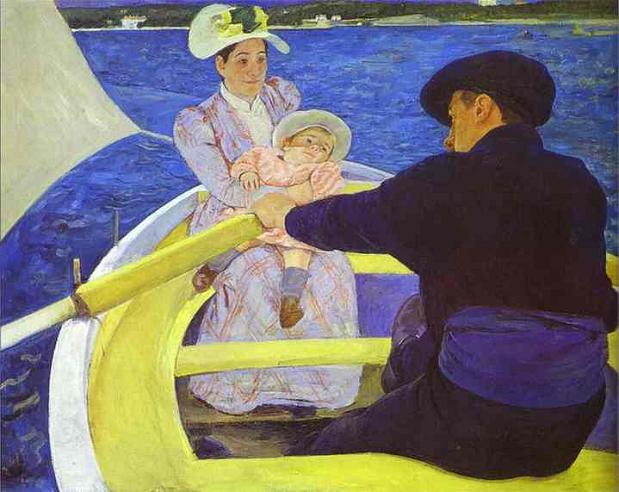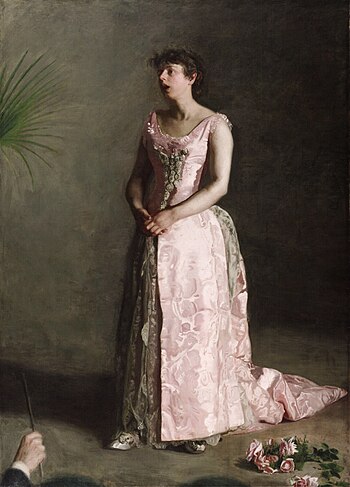Cassatt & Eakins
Post 2
To analyze the issues
that gender and gender roles played on impressionism, one must examine the
works of two American artists Mary Cassatt and her contemporary Thomas Eakins. Works
by Cassatt and Eakins seemed perfect to analyze because of how similar backgrounds
they share. Both Cassatt and Eakins were born mid-19th century and
studied at the Pennsylvania Academy of Fine Arts, but the key difference in examining
their works of art is that Cassatt was a woman and Eakins a man. I will be
analyzing Cassatt’s The Boating Party
and Woman in Black at the Opera and
Eakins’ Max Schmitt in a Single Scull and The Concert Singer (Weda Cook).
Painted in 1893-4, Cassatt’s The Boating Party is good example of how gender played a role in
art. Cassatt breaks away from placing focus on the male figure in the painting
instead places the focus on the woman and her child. Although the male figure
is prominent in the picture plane because of how he is place in the foreground,
Cassatt seems to keep him anonymous with how she gives the viewer only a
glimpse of his face and how is dressed in a darker color keeping him in the “shadows”.
The woman and child on the other hand are dressed in lighter colors and are
placed in the center of the picture plane directing eyes to them. True to
impressionist characteristics, Cassatt paints specific moments and rejects the form
of painting that existed before with her removal of spatial depth seen in her
consistent brushstrokes creating a flat image.
The difference are easier to notice when the subjects are
similar, as seen in Eakins’ Max Schmitt
in a Single Scull painted in 1871. Unlike Cassatt, Eakins’ painting was not
focusing on the woman but painted to portray Max Schmitt as a hero. As Eisenman
states at a time when rowing was becoming popular, Eakins portrays his friend
Schmitt as champion and hero of American life. Eakins also places focus on
Schmitt by placing him in the center of the painting and making Schmitt’s figure
look at the viewer. True to impressionist characteristics, Eakins depicts a specific
moment and how it appears in light.
In Cassatt’s Woman
in Black at the Opera the focus on women remains with her portrait of young
woman attending the opera. The female figure in Cassatt’s painting dominates
the picture plane is depicted very active. Cassatt has given her opera-goer the
power of the gaze which is signified through the use of opera glasses. Her
active looking is even emphasized with her fan slightly raised in excitement. The
man in the background looks at the opera-goer but she does not acknowledge his
gaze, similar to how she does not acknowledge the viewer looking at the
painting. Cassatt seems to depict a new type of modern woman, one who takes
part in cultural events. The impressionist characteristics present in the
painting are that Cassatt paints a visual representation of an experience,
which may have never been seen as an important for a male artist to depict. The
visible brushstrokes of the painting create a blurry and out of focus appearance
to the painting.
A less active figure is depicted in Eakins’ The Concert Singer. Although Eakins
portrayed Weda Cook actively singing, she seems passive because of her docile
pose. Eisenman states that Eakins interprets the singer as an instrument of
music rather than a creator of music. This is emphasized through Eakins
addition of male hand in the lower left corner which can be seen as sign of
masculine control and dominance. Cassatt address this in Woman in Black at the Opera with how the male gaze of the man in
the background does not affect the woman in the foreground. The impressionist
characteristics observed in Eakins painting are the representation of specific
moment and the depiction of the subject as she appears in light. It seems
gender and gender roles played an important role in the works of Cassatt and
Eakins because of what they considered as important to depict and how it was
depicted within the picture plane.
For more paintings by Cassatt click here
Works Cited
Eisenman, Stephen, and Thomas E. Crow. Nineteenth Century Art: A Critical History. 4th ed. London: Thames & Hudson, 2007. Print.




No comments:
Post a Comment